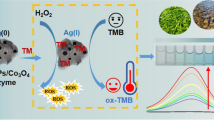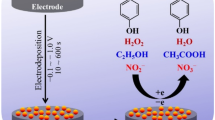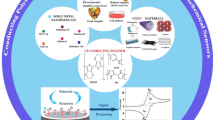Abstract
This paper demonstrates an effective method of monitoring glucose in fermentation processes based on the development of enzyme-free glucose electrochemical sensors. The sensing electrodes were manufactured by preparing size-controlled Au nanoparticles (NPs), in the form of colloidal solutions, which were dispersed on TiO2 substrates, and then deposited on commercial carbon screen printed electrodes. The as-synthesized samples were fully characterized by transmission electron microscopy, X-ray diffraction, atomic absorption spectroscopy, and UV–visible diffuse reflectance spectroscopy to obtain information about their morphological, structural, and electronic properties. Particularly, the ability to control the size of Au NPs in the colloidal solution by using different reducing agents and stabilizers is presented here. The Au/TiO2-based modified sensors were assembled and tested for glucose monitoring in an alkaline solution. Results of cyclic voltammetry showed the high electrocatalytic activity of these sensors toward glucose oxidation, whereas no response was detected toward ethanol. This suggests the possibility of using this type of sensor for glucose monitoring in the fermentation processes without ethanol interference. The efficient sensing properties of Au NP-embedded TiO2 composites may be ascribed to the higher electrocatalytic activity of smaller Au NPs stabilized on TiO2.










Similar content being viewed by others
References
Vojinović V, Cabral JMS, Fonseca LP (2006) Real-time bioprocess monitoring Part I: in situ sensors. Sens Actuators, B 114:1083–1091
Ampelli C, Casson V, Maschio G (2013) An integrated approach for the early detection of runaway reactions by using UV–visible and temperature sensors. Chem Eng Trans 32:733–738
Barthelmebs L, Calas-Blanchard C, Istamboulie G, Marty J-L, Noguer T (2010) Biosensors as analytical tools in food fermentation industry. In: Giardi MT, Rea G, Berra B (eds) Bio-farms for nutraceuticals: functional food and safety control by biosensors. Springer US, New York, pp 293–307
Yeung KSY, Hoare M, Thornhill NF, Williams T, Vaghjiani JD (1999) Near-infrared spectroscopy for bioprocess monitoring and control. Biotechnol Bioeng 63:684–693
Willson RC (1998) Purification and characterization of proteins. In: Demain AL, Davies JE (eds) Manual of industrial microbiology and biotechnology, 2nd edn. ASM Press, Washington, DC, pp 266–272
Wang P, Du M, Zhang M, Zhu H, Bao S, Zou M, Yang T (2014) Facile fabrication of AuNPs/PANI/HNTs nanostructures for high-performance electrochemical sensors towards hydrogen peroxide. Chem Eng J 248:307–314
Ghaedi M, Montazerozohori M, Sahraei R (2013) Comparison of the influence of nanomaterials on response properties of copper selective electrodes. J Ind Eng Chem 19:1356–1364
Karube I (1984) Possible developments in microbial and other sensors for fermentation control. Biotechnol Genet Eng 2:313–339
Brooks SL, Ashby RE, Turner APF, Calder MR, Clarke DJ (1987) Development of an on-line glucose sensor for fermentation monitoring. Biosensors 3:45–56
Ampelli C, Leonardi SG, Genovese C, Lanzafame P, Passalacqua R, Perathoner S, Centi G, Neri G (2014) Novel electrochemical sensors for safety and control in fermentation processes. Chem Eng Trans 36:319–324
Leonardi SG, Aloisio D, Donato N, Russo PA, Ferro MC, Pinna N, Neri G (2014) Amperometric sensing of H2O2 using Pt–TiO2/reduced graphene oxide nanocomposites. ChemElectroChem 1:617–624
Si P, Huang Y, Wanga T, Ma J (2013) Nanomaterials for electrochemical non-enzymatic glucose biosensors. RSC Adv 3:3487–3502
Ampelli C, Passalacqua R, Perathoner S, Centi G (2009) Nano-engineered materials for H2 production by water photo-electrolysis. Chem Eng Trans 17:1011–1016
Ampelli C, Perathoner S, Centi G (2014) Carbon-based catalysts: opening new scenario to develop next-generation nano-engineered catalytic materials. Chin J Catal 35:783–791
Ampelli C, Genovese C, Errahali M, Gatti G, Marchese L, Perathoner S, Centi G (2015) CO2 capture and reduction to liquid fuels in a novel electrochemical setup by using metal-doped conjugated microporous polymers. J Appl Electrochem. doi:10.1007/s10800-015-0847-7
Passalacqua R, Ampelli C, Perathoner S, Centi G (2012) Anodically Formed TiO2 Thin Films: evidence for a multiparameter dependent photocurrent–structure relationship. Nanosci Nanotechnol Lett 4:142–148
Ampelli C, Passalacqua R, Perathoner S, Centi G (2011) Development of a TiO2 nanotube array-based photo-reactor for H2 production by water splitting. Chem Eng Trans 24:187–192
Ampelli C, Spadaro D, Neri G, Donato N, Latino M, Passalacqua R, Perathoner S, Centi G (2012) Development of hydrogen leak sensors for fuel cell transportation. Chem Eng Trans 26:333–338
Ampelli C, Genovese C, Passalacqua R, Perathoner S, Centi G (2012) The use of a solar photoelectrochemical reactor for sustainable production of energy. Theor Found Chem Eng 46:651–657
Larew LA, Johnson DC (1989) Concentration dependence of the mechanism of glucose oxidation at gold electrodes in alkaline media. J Electroanal Chem 262:167–182
Adzic RR, Hsiao MW, Yeager EB (1989) Electrochemical oxidation of glucose on single crystal gold surfaces. J Electroanal Chem 260:475–485
Hussain M, Ahmad M, Nisar A, Sun H, Karim S, Khan M, Khan SD, Iqbal M, Hussain SZ (2014) Enhanced photocatalytic and electrochemical properties of Au nanoparticles supported TiO2 microspheres. N J Chem 38:1424–1432
Shin C, Shin W, Hong H-G (2007) Electrochemical fabrication and electrocatalytic characteristics studies of gold nanopillar array electrode (AuNPE) for development of a novel electrochemical sensor. Electrochim Acta 53:720–728
Tominaga M, Shimazoe T, Nagashima M, Taniguchi I (2005) Electrocatalytic oxidation of glucose at gold nanoparticle-modified carbon electrodes in alkaline and neutral solutions. Electrochem Commun 7:189–193
Wu B-Y, Hou S-H, Yin F, Zhao Z-X, Wang Y-Y, Wang X-S, Chen Q (2007) Amperometric glucose biosensor based on multilayer films via layer-by-layer self-assembly of multi-wall carbon nanotubes, gold nanoparticles and glucose oxidase on the Pt electrode. Biosens Bioelectron 22:2854–2860
Bai Y, Yang H, Yang W, Li Y, Sun C (2007) Gold nanoparticles-mesoporous silica composite used as an enzyme immobilization matrix for amperometric glucose biosensor construction. Sens Actuators, B 124:179–186
Thibault S, Aubriet H, Arnoult C, Ruch D (2008) Gold nanoparticles and a glucose oxidase based biosensor: an attempt to follow-up aging by XPS. Microchim Acta 163:211–217
Lee PC, Meisel D (1982) Adsorption and surface-enhanced Raman of dyes on silver and gold sols. J Phys Chem 86:3391–3395
Grabar KC, Freeman GR, Hommer MB, Natan MJ (1995) Preparation and characterization of Au colloid monolayers. Anal Chem 67:735–743
Yogi C, Kojima K, Hashishin T, Wada N, Inada Y, Della Gaspera E, Bersani M, Martucci A, Liu L, Sham T, Over H (2011) Size effect of au nanoparticles on TiO2 crystalline phase of nanocomposite thin films and their photocatalytic properties. J Phys Chem C 115:6554–6560
Ampelli C, Genovese C, Lanzafame P, Perathoner S, Centi G (2014) A sustainable production of H2 by water splitting and photo-reforming of organic wastes on Au/TiO2 nanotube arrays. Chem Eng Trans 39:1627–1632
Tian Y, Tatsuma T (2005) Mechanisms and applications of plasmon-induced charge separation at TiO2 films loaded with gold nanoparticles. J Am Chem Soc 127:7632–7637
Ampelli C, Genovese C, Passalacqua R, Perathoner S, Centi G (2014) A gas-phase reactor powered by solar energy and ethanol for H2 production. Appl Therm Eng 70:1270–1275
Ben Aoun S, Dursun Z, Koga T, Bang GS, Sotomura T, Taniguchi I (2004) Effect of metal ad-layers on Au(1 1 1) electrodes on electrocatalytic oxidation of glucose in an alkaline solution. J Electroanal Chem 567:175–183
Ben Aoun S, Bang GS, Koga T, Nonaka Y, Sotomura T, Taniguchi I (2003) Electrocatalytic oxidation of sugars on silver-UPD single crystal gold electrodes in alkaline solutions. Electrochem Commun 5:317–320
Feng D, Wang F, Chen Z (2009) Electrochemical glucose sensor based on one-step construction of gold nanoparticle–chitosan composite film. Sens Actuators, B 138:539–544
Arjona N, Guerra-Balcázar M, Trejo G, Ledesma-García J, Arriaga LG (2012) Electrochemical growth of Au architectures on glassy carbon and their evaluation toward glucose oxidation reaction. N J Chem 36:2555–2561
Ben Aoun S (2013) Size-controlled electrocatalysis of glucose oxidation in an alkaline solution at AuNPs electrodeposited onto glassy carbon electrodes. Int J Electrochem Sci 8:10454–10460
Yi Q, Niu F, Yu W (2011) Pd-modified TiO2 electrode for electrochemical oxidation of hydrazine, formaldehyde and glucose. Thin Solid Films 519:3155–3161
Burke LD, O’Dwyer KJ (1989) Mediation of oxidation reactions at noble metal anodes by low levels of in situ generated hydroxy species. Electrochim Acta 34:1659–1664
Burke LD, Ryan TG (1992) The role of incipient hydrous oxides in the oxidation of glucose and some of its derivatives in aqueous media. Electrochim Acta 37:1363–1370
Toghill KE, Compton RG (2010) Electrochemical non-enzymatic glucose sensors: a perspective and an evaluation. Int J Electrochem Sci 5:1246–1301
Pasta M, Ruffo R, Falletta E, Mari CM, Della Pina C (2010) Alkaline glucose oxidation on nanostructured gold electrodes. Gold Bull 43:57–64
Zhu H, Lu X, Li M, Shao Y, Zhu Z (2009) Nonenzymatic glucose voltammetric sensor based on gold nanoparticles/carbon nanotubes/ionic liquid nanocomposite. Talanta 79:1446–1453
Zhu X, Li C, Zhu X, Xu M (2012) Nonenzymatic glucose sensor based on Pt–Au-SWCNTs nanocomposites. Int J Electrochem Sci 7:8522–8532
Su S-H, Cheng H, Chen P-Y (2013) Electrochemical oxidation and determination of glucose using cyclic voltammetry and a one-step prepared nanoporous gold wire electrode. J Chin Chem Soc 60:1380–1386
Khan MM, Ansari SA, Lee J, Cho MH (2013) Enhanced optical, visible light catalytic and electrochemical properties of Au@TiO2 nanocomposites. J Ind Eng Chem 19:1845–1850
Brennan LJ, Purcell-Milton F, Salmeron AS, Zhang H, Govorov AO, Fedorov AV, Gun’ko YK (2015) Hot plasmonic electrons for generation of enhanced photocurrent in gold–TiO2 nanocomposites. Nanoscale Res Lett 10:38
Fang J, Cao S-W, Wang Z, Shahjamali MM, Loo SCJ, Barber J, Xue C (2012) Mesoporous plasmonic Au–TiO2 nanocomposites for efficient visible-light-driven photocatalytic water reduction. Int J Hydrog Energy 37:17853–17861
Ampelli C, Passalacqua R, Perathoner S, Centi G, Su DSS, Weinberg G (2008) Synthesis of TiO2 Thin films: relationship between preparation conditions and nanostructure. Top Catal 50(1–4):133–144
Acknowledgments
The authors thank Mr. Phill Robinson and Mr. Domenic Gugliandolo for their kind help in the revision of the manuscript.
Author information
Authors and Affiliations
Corresponding author
Rights and permissions
About this article
Cite this article
Ampelli, C., Leonardi, S.G., Genovese, C. et al. Monitoring of glucose in fermentation processes by using Au/TiO2 composites as novel modified electrodes. J Appl Electrochem 45, 943–951 (2015). https://doi.org/10.1007/s10800-015-0874-4
Received:
Accepted:
Published:
Issue Date:
DOI: https://doi.org/10.1007/s10800-015-0874-4




